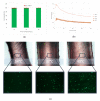Sodium Alginate/Gelatine Hydrogels for Direct Bioprinting-The Effect of Composition Selection and Applied Solvents on the Bioink Properties
- PMID: 31443354
- PMCID: PMC6747833
- DOI: 10.3390/ma12172669
Sodium Alginate/Gelatine Hydrogels for Direct Bioprinting-The Effect of Composition Selection and Applied Solvents on the Bioink Properties
Abstract
Hydrogels tested and evaluated in this study were developed for the possibility of their use as the bioinks for 3D direct bioprinting. Procedures for preparation and sterilization of hydrogels and the speed of the bioprinting were developed. Sodium alginate gelatine hydrogels were characterized in terms of printability, mechanical, and biological properties (viability, proliferation ability, biocompatibility). A hydrogel with the best properties was selected to carry out direct bioprinting tests in order to determine the parameters of the bioink, adapted to print with use of the designed and constructed bioprinter and provide the best conditions for cell growth. The obtained results showed the ability to control mechanical properties, biological response, and degradation rate of hydrogels through the use of various solvents. The use of a dedicated culture medium as a solvent for the preparation of a bioink, containing the predicted cell line, increases the proliferation of these cells. Modification of the percentage of individual components of the hydrogel gives the possibility of a controlled degradation process, which, in the case of printing of temporary medical devices, is a very important parameter for the hydrogels' usage possibility-both in terms of tissue engineering and printing of tissue elements replacement, implants, and organs.
Keywords: bioink for scaffolds; bioprinting; cell viability; degradation of hydrogels; mechanical properties; micro-extrusion.
Conflict of interest statement
The authors declare no conflict of interest. The funders had no role in the design of the study; in the collection, analyses, or interpretation of data; in the writing of the manuscript, or in the decision to publish the results.
Figures










References
-
- Caló E., Khutoryanskiy V.V. Biomedical applications of hydrogels: A review of patents and commercial products. Eur. Polym. J. 2015;65:252–267. doi: 10.1016/j.eurpolymj.2014.11.024. - DOI
Grants and funding
LinkOut - more resources
Full Text Sources

